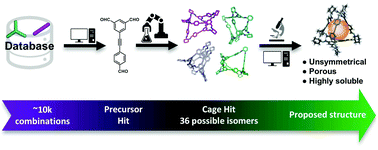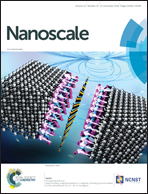Computationally-inspired discovery of an unsymmetrical porous organic cage†
Abstract
A completely unsymmetrical porous organic cage was synthesised from a C2v symmetrical building block that was identified by a computational screen. The cage was formed through a 12-fold imine condensation of a tritopic C2v symmetric trialdehyde with a ditopic C2 symmetric diamine in a [4 + 6] reaction. The cage was rigid and microporous, as predicted by the simulations, with an apparent Brunauer–Emmett–Teller surface area of 578 m2 g−1. The reduced symmetry of the tritopic building block relative to its topicity meant there were 36 possible structural isomers of the cage. Experimental characterisation suggests a single isomer with 12 unique imine environments, but techniques such as NMR could not conclusively identify the isomer. Computational structural and electronic analysis of the possible isomers was used to identify the most likely candidates, and hence to construct a 3-dimensional model of the amorphous solid. The rational design of unsymmetrical cages using building blocks with reduced symmetry offers new possibilities in controlling the degree of crystallinity, porosity, and solubility, of self-assembled materials.



 Please wait while we load your content...
Please wait while we load your content...